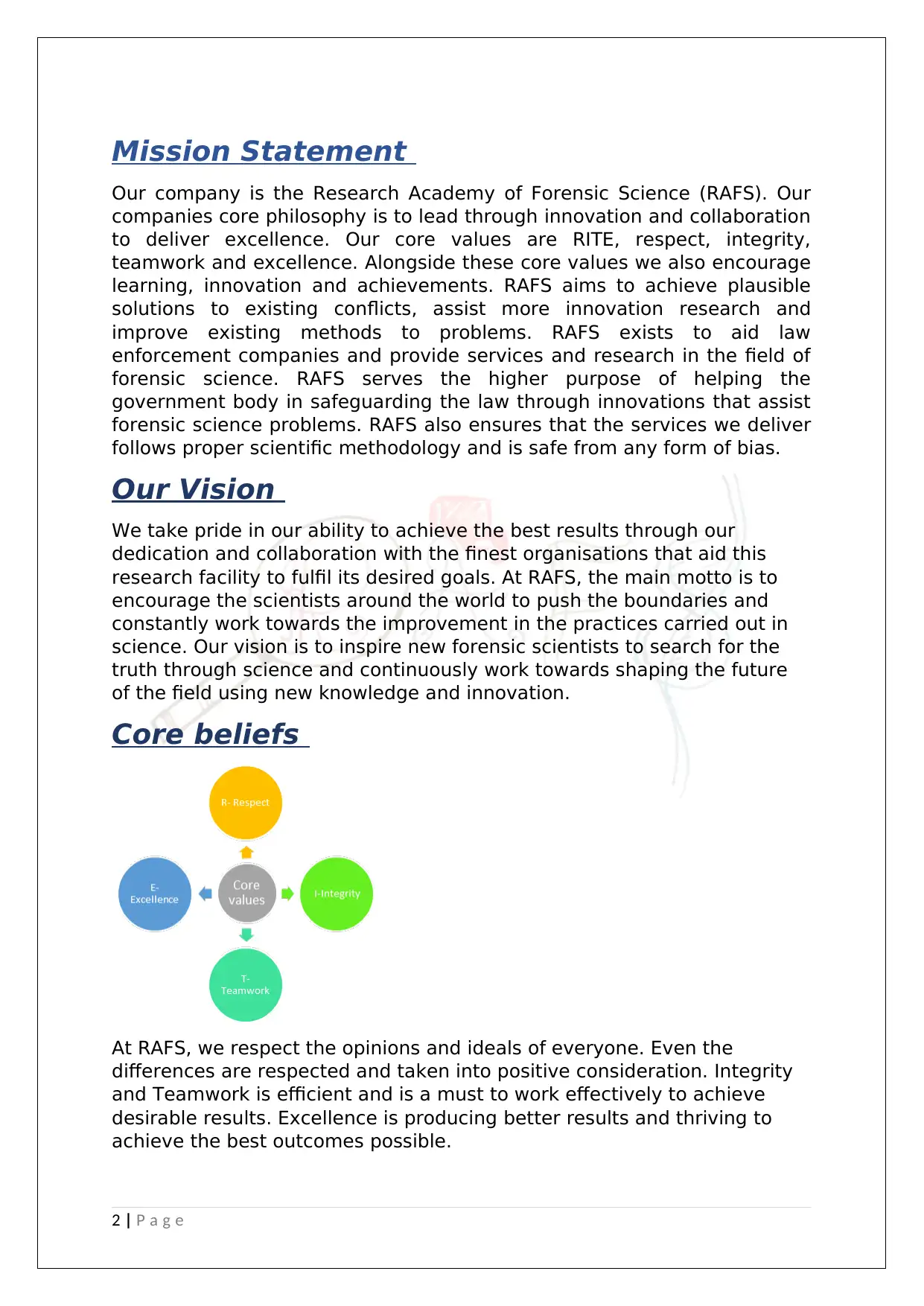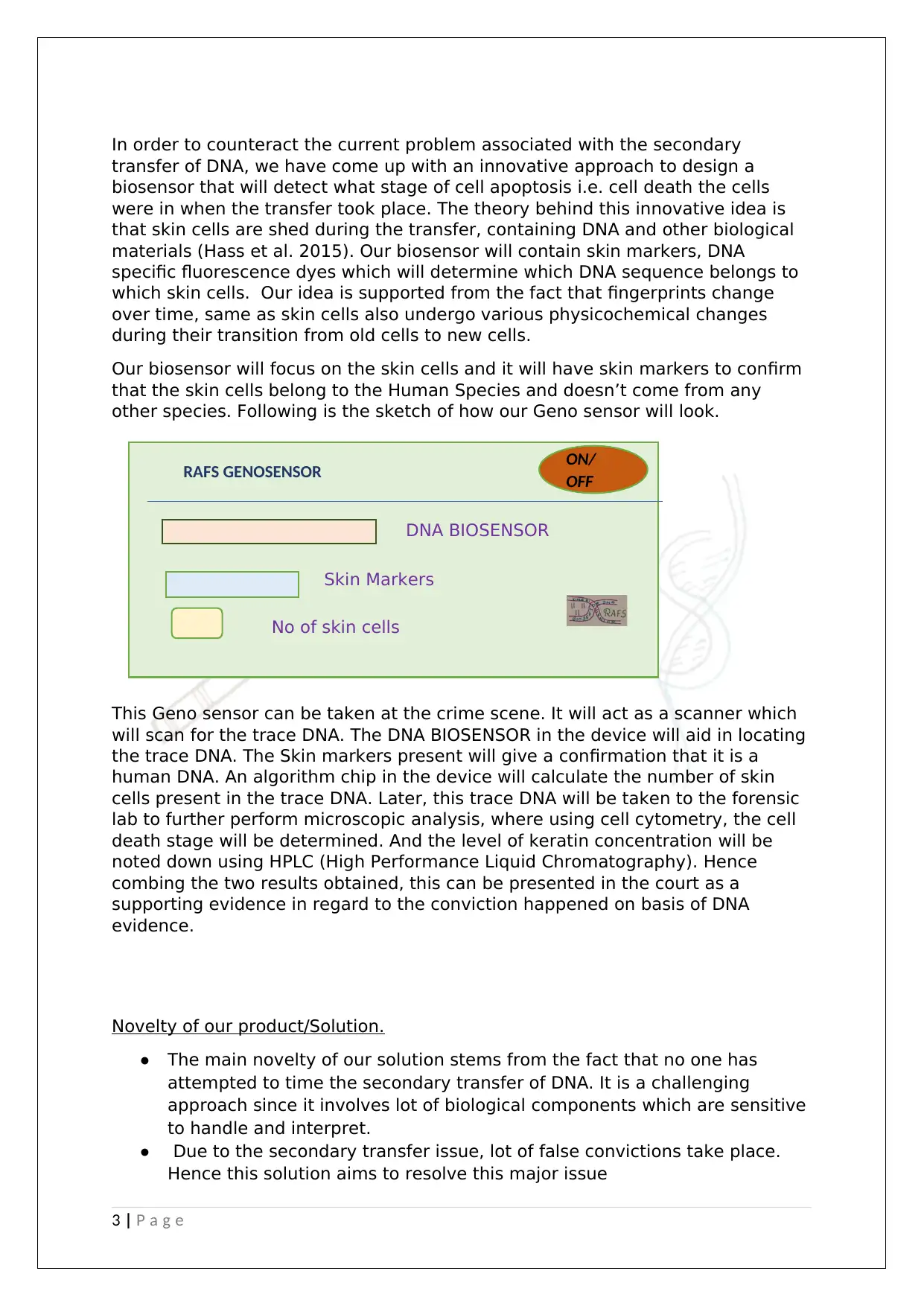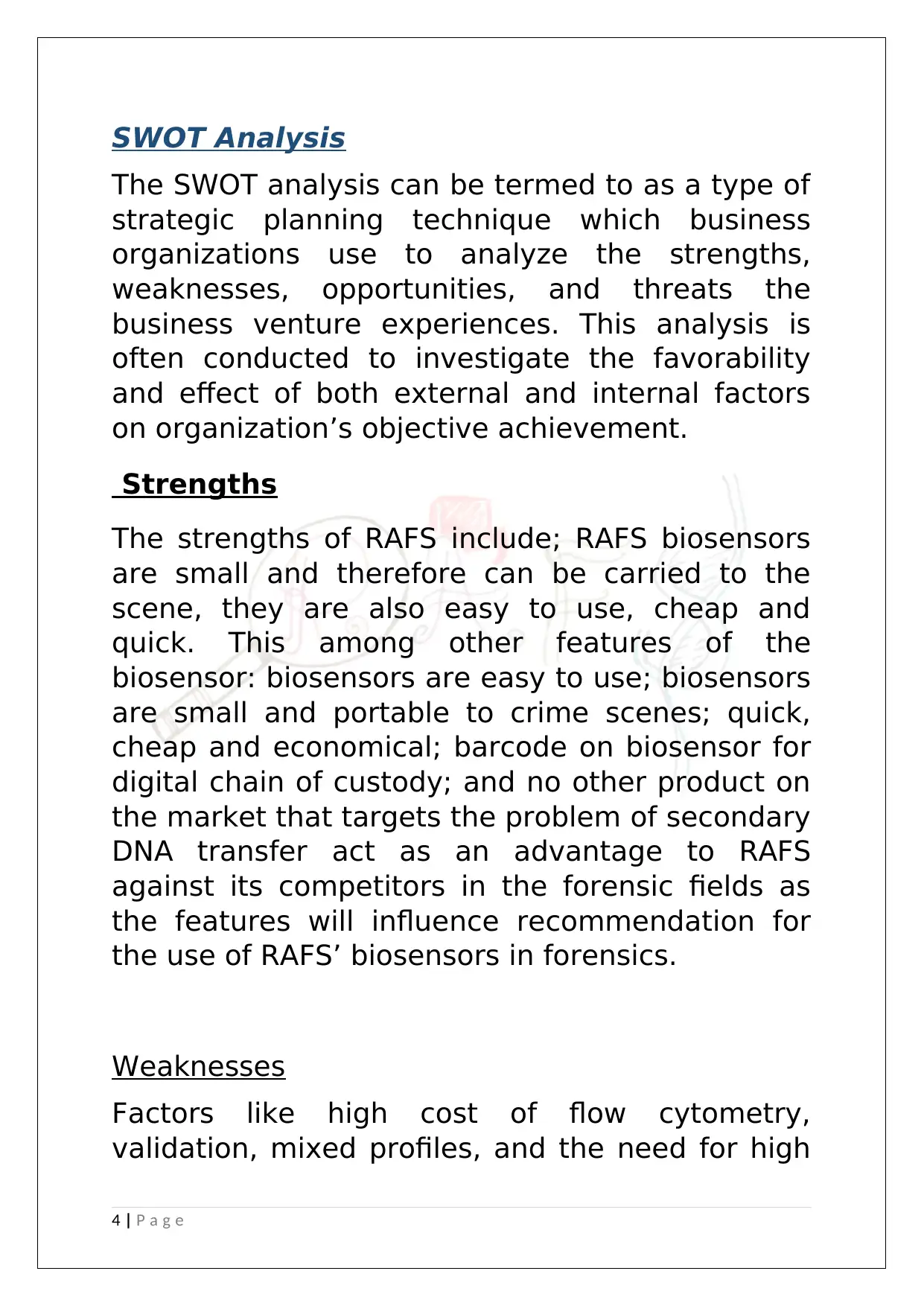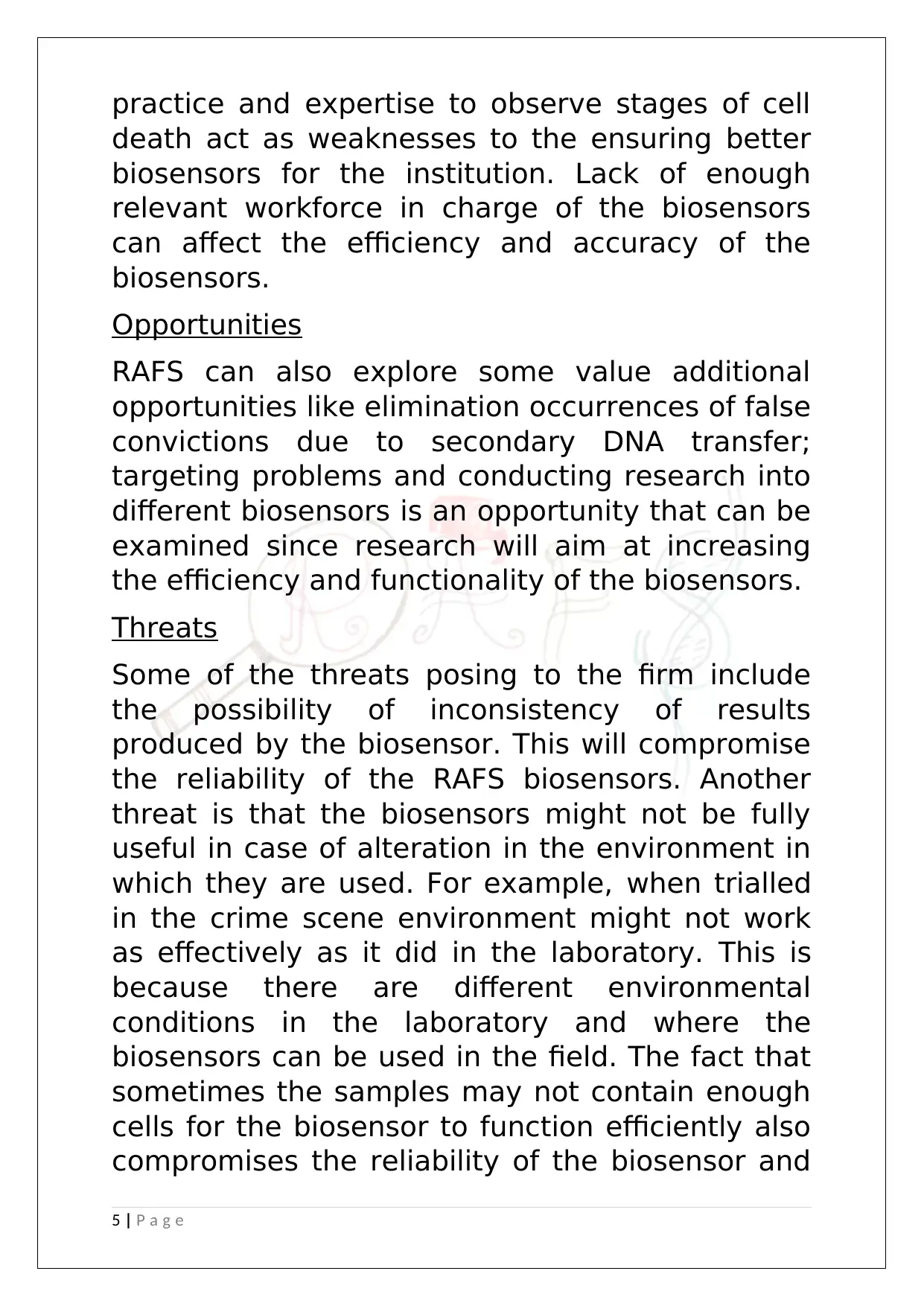Innovative Biosensor for Secondary Transfer of DNA - RAFS
VerifiedAdded on 2023/06/11
|6
|1274
|266
AI Summary
RAFS has developed an innovative biosensor to detect the stage of cell apoptosis in skin cells during secondary transfer of DNA. The biosensor contains skin markers and DNA-specific fluorescence dyes to determine the DNA sequence and skin cells belonging to the human species. The biosensor can be used at the crime scene and presented as supporting evidence in court.
Contribute Materials
Your contribution can guide someone’s learning journey. Share your
documents today.

BUSINESS PLAN
by
MAY 20, 2018
RESEARCH ACADEMY OF FORENSIC SCIENCE
GROUP 20
HELI SONI (12842225)
NICHOLA CRAIGE
(13186147)
MEGHANA REDDY
(13117989)
by
MAY 20, 2018
RESEARCH ACADEMY OF FORENSIC SCIENCE
GROUP 20
HELI SONI (12842225)
NICHOLA CRAIGE
(13186147)
MEGHANA REDDY
(13117989)
Secure Best Marks with AI Grader
Need help grading? Try our AI Grader for instant feedback on your assignments.

Research
Academy of
Forensic Science
1 | P a g e
Academy of
Forensic Science
1 | P a g e

Mission Statement
Our company is the Research Academy of Forensic Science (RAFS). Our
companies core philosophy is to lead through innovation and collaboration
to deliver excellence. Our core values are RITE, respect, integrity,
teamwork and excellence. Alongside these core values we also encourage
learning, innovation and achievements. RAFS aims to achieve plausible
solutions to existing conflicts, assist more innovation research and
improve existing methods to problems. RAFS exists to aid law
enforcement companies and provide services and research in the field of
forensic science. RAFS serves the higher purpose of helping the
government body in safeguarding the law through innovations that assist
forensic science problems. RAFS also ensures that the services we deliver
follows proper scientific methodology and is safe from any form of bias.
Our Vision
We take pride in our ability to achieve the best results through our
dedication and collaboration with the finest organisations that aid this
research facility to fulfil its desired goals. At RAFS, the main motto is to
encourage the scientists around the world to push the boundaries and
constantly work towards the improvement in the practices carried out in
science. Our vision is to inspire new forensic scientists to search for the
truth through science and continuously work towards shaping the future
of the field using new knowledge and innovation.
Core beliefs
At RAFS, we respect the opinions and ideals of everyone. Even the
differences are respected and taken into positive consideration. Integrity
and Teamwork is efficient and is a must to work effectively to achieve
desirable results. Excellence is producing better results and thriving to
achieve the best outcomes possible.
2 | P a g e
Our company is the Research Academy of Forensic Science (RAFS). Our
companies core philosophy is to lead through innovation and collaboration
to deliver excellence. Our core values are RITE, respect, integrity,
teamwork and excellence. Alongside these core values we also encourage
learning, innovation and achievements. RAFS aims to achieve plausible
solutions to existing conflicts, assist more innovation research and
improve existing methods to problems. RAFS exists to aid law
enforcement companies and provide services and research in the field of
forensic science. RAFS serves the higher purpose of helping the
government body in safeguarding the law through innovations that assist
forensic science problems. RAFS also ensures that the services we deliver
follows proper scientific methodology and is safe from any form of bias.
Our Vision
We take pride in our ability to achieve the best results through our
dedication and collaboration with the finest organisations that aid this
research facility to fulfil its desired goals. At RAFS, the main motto is to
encourage the scientists around the world to push the boundaries and
constantly work towards the improvement in the practices carried out in
science. Our vision is to inspire new forensic scientists to search for the
truth through science and continuously work towards shaping the future
of the field using new knowledge and innovation.
Core beliefs
At RAFS, we respect the opinions and ideals of everyone. Even the
differences are respected and taken into positive consideration. Integrity
and Teamwork is efficient and is a must to work effectively to achieve
desirable results. Excellence is producing better results and thriving to
achieve the best outcomes possible.
2 | P a g e

Our Product
In order to counteract the current problem associated with the secondary
transfer of DNA, we have come up with an innovative approach to design a
biosensor that will detect what stage of cell apoptosis i.e. cell death the cells
were in when the transfer took place. The theory behind this innovative idea is
that skin cells are shed during the transfer, containing DNA and other biological
materials (Hass et al. 2015). Our biosensor will contain skin markers, DNA
specific fluorescence dyes which will determine which DNA sequence belongs to
which skin cells. Our idea is supported from the fact that fingerprints change
over time, same as skin cells also undergo various physicochemical changes
during their transition from old cells to new cells.
Our biosensor will focus on the skin cells and it will have skin markers to confirm
that the skin cells belong to the Human Species and doesn’t come from any
other species. Following is the sketch of how our Geno sensor will look.
This Geno sensor can be taken at the crime scene. It will act as a scanner which
will scan for the trace DNA. The DNA BIOSENSOR in the device will aid in locating
the trace DNA. The Skin markers present will give a confirmation that it is a
human DNA. An algorithm chip in the device will calculate the number of skin
cells present in the trace DNA. Later, this trace DNA will be taken to the forensic
lab to further perform microscopic analysis, where using cell cytometry, the cell
death stage will be determined. And the level of keratin concentration will be
noted down using HPLC (High Performance Liquid Chromatography). Hence
combing the two results obtained, this can be presented in the court as a
supporting evidence in regard to the conviction happened on basis of DNA
evidence.
Novelty of our product/Solution.
● The main novelty of our solution stems from the fact that no one has
attempted to time the secondary transfer of DNA. It is a challenging
approach since it involves lot of biological components which are sensitive
to handle and interpret.
● Due to the secondary transfer issue, lot of false convictions take place.
Hence this solution aims to resolve this major issue
3 | P a g e
ON/
OFF
DNA BIOSENSOR
Skin Markers
No of skin cells
RAFS GENOSENSOR
In order to counteract the current problem associated with the secondary
transfer of DNA, we have come up with an innovative approach to design a
biosensor that will detect what stage of cell apoptosis i.e. cell death the cells
were in when the transfer took place. The theory behind this innovative idea is
that skin cells are shed during the transfer, containing DNA and other biological
materials (Hass et al. 2015). Our biosensor will contain skin markers, DNA
specific fluorescence dyes which will determine which DNA sequence belongs to
which skin cells. Our idea is supported from the fact that fingerprints change
over time, same as skin cells also undergo various physicochemical changes
during their transition from old cells to new cells.
Our biosensor will focus on the skin cells and it will have skin markers to confirm
that the skin cells belong to the Human Species and doesn’t come from any
other species. Following is the sketch of how our Geno sensor will look.
This Geno sensor can be taken at the crime scene. It will act as a scanner which
will scan for the trace DNA. The DNA BIOSENSOR in the device will aid in locating
the trace DNA. The Skin markers present will give a confirmation that it is a
human DNA. An algorithm chip in the device will calculate the number of skin
cells present in the trace DNA. Later, this trace DNA will be taken to the forensic
lab to further perform microscopic analysis, where using cell cytometry, the cell
death stage will be determined. And the level of keratin concentration will be
noted down using HPLC (High Performance Liquid Chromatography). Hence
combing the two results obtained, this can be presented in the court as a
supporting evidence in regard to the conviction happened on basis of DNA
evidence.
Novelty of our product/Solution.
● The main novelty of our solution stems from the fact that no one has
attempted to time the secondary transfer of DNA. It is a challenging
approach since it involves lot of biological components which are sensitive
to handle and interpret.
● Due to the secondary transfer issue, lot of false convictions take place.
Hence this solution aims to resolve this major issue
3 | P a g e
ON/
OFF
DNA BIOSENSOR
Skin Markers
No of skin cells
RAFS GENOSENSOR
Secure Best Marks with AI Grader
Need help grading? Try our AI Grader for instant feedback on your assignments.

SWOT Analysis
The SWOT analysis can be termed to as a type of
strategic planning technique which business
organizations use to analyze the strengths,
weaknesses, opportunities, and threats the
business venture experiences. This analysis is
often conducted to investigate the favorability
and effect of both external and internal factors
on organization’s objective achievement.
Strengths
The strengths of RAFS include; RAFS biosensors
are small and therefore can be carried to the
scene, they are also easy to use, cheap and
quick. This among other features of the
biosensor: biosensors are easy to use; biosensors
are small and portable to crime scenes; quick,
cheap and economical; barcode on biosensor for
digital chain of custody; and no other product on
the market that targets the problem of secondary
DNA transfer act as an advantage to RAFS
against its competitors in the forensic fields as
the features will influence recommendation for
the use of RAFS’ biosensors in forensics.
Weaknesses
Factors like high cost of flow cytometry,
validation, mixed profiles, and the need for high
4 | P a g e
The SWOT analysis can be termed to as a type of
strategic planning technique which business
organizations use to analyze the strengths,
weaknesses, opportunities, and threats the
business venture experiences. This analysis is
often conducted to investigate the favorability
and effect of both external and internal factors
on organization’s objective achievement.
Strengths
The strengths of RAFS include; RAFS biosensors
are small and therefore can be carried to the
scene, they are also easy to use, cheap and
quick. This among other features of the
biosensor: biosensors are easy to use; biosensors
are small and portable to crime scenes; quick,
cheap and economical; barcode on biosensor for
digital chain of custody; and no other product on
the market that targets the problem of secondary
DNA transfer act as an advantage to RAFS
against its competitors in the forensic fields as
the features will influence recommendation for
the use of RAFS’ biosensors in forensics.
Weaknesses
Factors like high cost of flow cytometry,
validation, mixed profiles, and the need for high
4 | P a g e

practice and expertise to observe stages of cell
death act as weaknesses to the ensuring better
biosensors for the institution. Lack of enough
relevant workforce in charge of the biosensors
can affect the efficiency and accuracy of the
biosensors.
Opportunities
RAFS can also explore some value additional
opportunities like elimination occurrences of false
convictions due to secondary DNA transfer;
targeting problems and conducting research into
different biosensors is an opportunity that can be
examined since research will aim at increasing
the efficiency and functionality of the biosensors.
Threats
Some of the threats posing to the firm include
the possibility of inconsistency of results
produced by the biosensor. This will compromise
the reliability of the RAFS biosensors. Another
threat is that the biosensors might not be fully
useful in case of alteration in the environment in
which they are used. For example, when trialled
in the crime scene environment might not work
as effectively as it did in the laboratory. This is
because there are different environmental
conditions in the laboratory and where the
biosensors can be used in the field. The fact that
sometimes the samples may not contain enough
cells for the biosensor to function efficiently also
compromises the reliability of the biosensor and
5 | P a g e
death act as weaknesses to the ensuring better
biosensors for the institution. Lack of enough
relevant workforce in charge of the biosensors
can affect the efficiency and accuracy of the
biosensors.
Opportunities
RAFS can also explore some value additional
opportunities like elimination occurrences of false
convictions due to secondary DNA transfer;
targeting problems and conducting research into
different biosensors is an opportunity that can be
examined since research will aim at increasing
the efficiency and functionality of the biosensors.
Threats
Some of the threats posing to the firm include
the possibility of inconsistency of results
produced by the biosensor. This will compromise
the reliability of the RAFS biosensors. Another
threat is that the biosensors might not be fully
useful in case of alteration in the environment in
which they are used. For example, when trialled
in the crime scene environment might not work
as effectively as it did in the laboratory. This is
because there are different environmental
conditions in the laboratory and where the
biosensors can be used in the field. The fact that
sometimes the samples may not contain enough
cells for the biosensor to function efficiently also
compromises the reliability of the biosensor and
5 | P a g e
1 out of 6
Your All-in-One AI-Powered Toolkit for Academic Success.
+13062052269
info@desklib.com
Available 24*7 on WhatsApp / Email
![[object Object]](/_next/static/media/star-bottom.7253800d.svg)
Unlock your academic potential
© 2024 | Zucol Services PVT LTD | All rights reserved.
